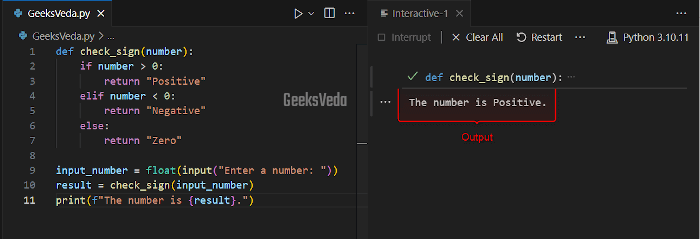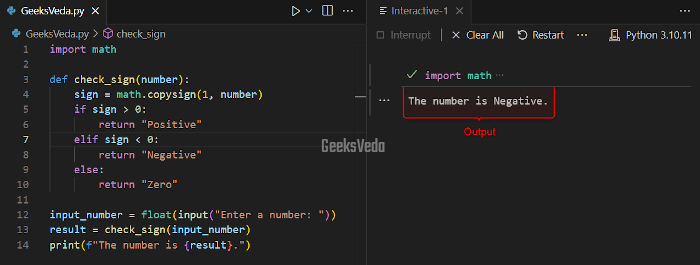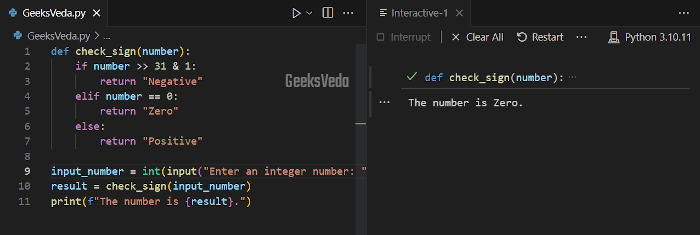In Python programming, the behavior of algorithms, logical decisions, and real-world simulations often depends on the sign of a number. For this purpose, Python offers multiple methods for determining whether a number is positive, negative, or zero.
This guide discusses different techniques for checking signs in Python. From traditional if-else statements to versatile math functions, ternary operators, built-in functions, and concise ternary operators, we have got you covered!
Why You Should Check the Number Sign in Python
In Python, numbers play a significant role in performing different calculations and operations. More specifically, the sign of a number is of great importance and can influence the behavior of algorithms, logical decisions, and real-world simulations.
This sign-checking operation is also considered the base of different scenarios.
To dive deep into the use cases of sign-checking in Python, look at the given list:
- Financial Logic – Managing transactions by distinguishing credits and debits.
- Data Analysis – Filtering data sets for positive, negative, and zero values.
- User Input – Validating input constraints for positive values.
- Simulation Control – Influencing simulations based on signs for accurate outcomes.
- Game Mechanics – Governing game elements’ interactions and movements.
- Algorithmic Decisions – Directing algorithms based on sign conditions.
- Error Handling – Identifying errors through result signs for better feedback.
- Statistics – Categorizing data points to compute averages and metrics.
- Machine Learning – Enhancing models with engineered features based on signs.
- Mathematical Adjustments – Modifying operations based on sign implications.
How to Check if a Number is Positive, Negative, or 0 in Python
In order to check or verify if a number is positive, negative, or 0 in Python, using:
- if-else Statements
- Ternary Operator
- Math Functions
- Bit Manipulation
1. Using if-else Statements
Using an if-else statement is one of the traditional approaches for determining the sign of a number in Python.
It enables you to define certain actions based on the specified conditions. More specifically, this statement can assist in verifying if a number is positive, negative, or zero.
For instance, in the following program, we have defined a function named “check_sign()“. This function accepts a number as an input and utilizes the if-else statement for determining its sign.
Depending on the value entered by you, the function will return the added message.
def check_sign(number):
if number > 0:
return "Positive"
elif number < 0:
return "Negative"
else:
return "Zero"
input_number = float(input("Enter a number: "))
result = check_sign(input_number)
print(f"The number is {result}.")
In this case, we will enter “5” as a positive number. It can be observed that the number is displayed as being positive.

2. Using Ternary Operator
Ternary operator offers simple and shorthand conditional expressions. It reduces the if-else statement into a single line which makes it ideal for simple sign-checking scenarios where concise code is preferred.
In the following code, we have a “check_sign()” function that utilizes a ternary operator to check if the entered number is positive, negative, or zero, in a more compact form.
def check_sign(number):
return "Positive" if number > 0 else "Negative" if number < 0 else "Zero"
input_number = float(input("Enter a number: "))
result = check_sign(input_number)
print(f"The number is {result}.")
We will now enter a negative number “-7” as input. This will resultantly display the message that the number is negative.

3. Using Math Functions
Python’s “math” module provides a “copysign()” method that provides an innovative way for extracting the sign of a number. By invoking this function, you are allowed to directly obtain the sign of a number regardless of its magnitude.
Here, firstly, we will import the “math” module and define the “check_sign()” function. It then invokes the “math.copy()” method for extracting the sign, followed by the “if-else” structure for determining the result.
import math
def check_sign(number):
sign = math.copysign(1, number)
if sign > 0:
return "Positive"
elif sign < 0:
return "Negative"
else:
return "Zero"
input_number = float(input("Enter a number: "))
result = check_sign(input_number)
print(f"The number is {result}.")

4. Using Bit Manipulation
Bit manipulation is considered an unconventional approach. However, it can be used for checking the sign of a number. It examines the leftmost bit to decide whether the number is negative, positive, or zero by considering the two’s complement representation.
According to the given code, we have a “check_sign()” function which deploys the bit manipulation technique for checking the sign of an integer number.
By shifting the number right by 31 bits and applying the bitwise AND operation, the leftmost bit value will be extracted.
def check_sign(number):
if number >> 31 & 1:
return "Negative"
elif number == 0:
return "Zero"
else:
return "Positive"
input_number = int(input("Enter an integer number: "))
result = check_sign(input_number)
print(f"The number is {result}.")

Choosing Which Method is Right to Check Sign
Let’s compare all of the discussed approaches to sign-checking in Python:
| Method | Advantages | Disadvantages | Use Cases |
| if-else Statements |
|
|
Quick sign checks in simple conditions. |
| Ternary Operator |
|
|
Compact sign checks in concise code segments. |
| Math Functions |
|
|
Situations requiring sign extraction in mathematical contexts. |
| Bit Manipulation |
|
|
Situations where understanding bit manipulation is desired. |
That’s brought us to the end of the Python sign-checking guide.
Conclusion
The ability to check the sign of a number is applied in different scenarios. Therefore, in this guide, we have explored different methods to check if a number is positive, negative, or zero in Python.
From traditional if-else statements to versatile math functions, ternary operators, built-in functions, and concise ternary operators, we demonstrated each technique with practical examples.
Want to explore and learn more related to Python, do check out our dedicated Python Tutorial Series!
